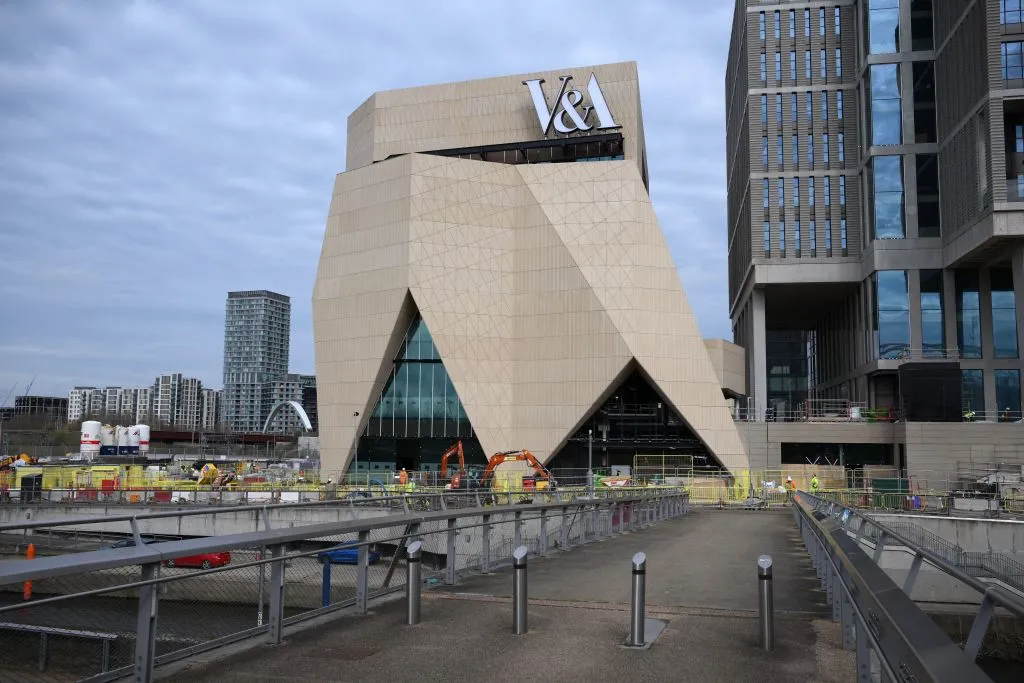The Headlines
A MUSEUM FOR GEN Z. Gus Casely-Hayford, director of the new V&A East, wants London’s long-awaited cultural hub to spark creative passion in Gen Z visitors, he told the Guardian. “As a child, he often felt excluded from museums, sensing they didn’t tell the stories of Black British people like him. His sister Margaret changed his perspective, telling him, “These spaces belong to all of us, and you can change them.” Now, he’s fulfilling that promise by creating a museum where young people can experience transformative moments that might shape their futures. V&A East spans two sites in London’s Olympic Park: the V&A Storehouse, which opened in May and quickly surpassed visitor targets, and the forthcoming V&A East Museum, a striking five-story building by Irish architects O’Donnell & Tuomey on Stratford Waterfront. Both aim to make the V&A’s vast collection accessible to audiences historically overlooked by major cultural institutions. After years of pandemic delays and construction challenges, the museum will open next year on April 18. Part of the £1.1 billion ($1.43 billion) East Bank development, a legacy of the 2012 Olympics, it joins Sadler’s Wells East, London College of Fashion, UCL East, and BBC Music Studios. Casely-Hayford hints that the V&A received a “very generous” slice of government funding for this ambitious vision.
HEAR, HEAR. As Gideon Taylor, the president of the World Jewish Restitution Organization (WJRO), writes in The Art Newspaper, Jewish couple Paul and Alice Leffmann fled Nazi Germany in 1938, entrusting their cherished Picasso painting, The Actor (1904), to a non-Jewish acquaintance in hopes it would survive the war. Forced to sell the work under duress to finance their escape to Brazil, the Leffmanns lost a priceless part of their lives. The painting has hung in New York’s Metropolitan Museum of Art since 1952. In 2016, the couple’s heir, Laurel Zuckerman, sought its return, but US courts dismissed the case on procedural grounds, exemplifying how legal technicalities still block restitution for Holocaust-era losses. A 2024 report from the WJRO found that American museums hold over 100,000 objects once in Europe during the Nazi era, yet less than 10 percent have transparent provenance records. The closure of the Nazi Era Provenance Internet Portal has further hindered heirs’ searches. Renewed legislation, the 2025 Holocaust Expropriated Art Recovery (HEAR) Act, aims to extend the 2016 law, remove barriers like time-based defenses, and ensure claimants can act once property is located. “Now is the time for Congress to pass the new HEAR Act, for museums to greatly enhance provenance research efforts and to make the results accessible, and for US officials and the US museum community to establish a commission. We owe it to aging Holocaust survivors and their families. Justice delayed is justice denied—but it is not yet too late,” Taylor argues.
The Digest
British aristocrat Charles March, aka the 11th Duke of Kent, opened his new show of minimalist, abstract photographs at London’s Hamiltons Gallery on Tuesday, November 4. Titled “Sandscript,” the exhibition runs through January 16 and “recalls the fluid brushwork of Chinese ink painting,” he said. [ARTnews]
The multiarmed Vaillancourt Fountain, a polarizing San Francisco landmark, will be dismantled after the city’s Arts Commission voted on Monday, November 3 to remove it because of safety concerns. [CBS News]
Sara Terry, the photographer who captured the effects of war on people and landscapes, documenting the traumatic aftermath of conflicts in places like Bosnia and Sierra Leone, died in October. She was 70. [New York Times]
A 2,200-year-old gold coin has been discovered by a metal detectorist in eastern Germany. Known as “rainbow cups” for their curved shape and the folklore that treasure can be found where a rainbow touches the ground, such coins were minted by the Celts, who did not inhabit this region. [Live Science]
The Kicker
SOTHEBY’S TOUR IN PARIS. ARTnews was given an impromptu tour of Manny Davidson’s collection on Monday, November 3 at Sotheby’s Paris HQ by Chloe Stead, the house’s global head of private sale, Old Masters. Spanning three sales and almost 500 lots, the trove includes rediscovered Old Masters, 19th century British paintings, 18th-century gold enamel, an automaton clock by the celebrated James Cox, and other bits and bobs will hit the auction block. Sotheby’s will hope that Michael Sweerts’ A young man wearing a turban holding an upturned roemer: the fingernail test (1648–52) carries the momentum of his rediscovered still-life that sold for over $16 million at Christie’s in 2023. The bartender is squeezed into the gilt frame. “I love this painting because the size is so surprising, and the crop—he really takes up the whole picture,” Stead said. “It feels like you’re glimpsing through a window.” The estimate on the label read €800,000 to €1.2 million ($919,000 to $1.38 million). Stead told me that in the catalog, the estimate of the guaranteed lot is actually lower because “French law dictates that, unlike in the UK, you can’t have a guarantee above the low estimate, so you have to change the estimate accordingly.” Portrait of a silversmith, probably Christiaen van Vianen (1600–1667) by Thomas de Keyser was hung next to it. “It’s a very chic picture,” Stead said. Its estimate: €400,000 to €600,000 ($459,000 to $689,000). In the work, Van Vianen is holding a silver salt cellar in his right hand. Displayed in a cabinet to the right of the painting was an almost identical silver salt cellar from the year 1600, probably made by Gabriel van den Velden. A nice touch, and yours for €30,000 to €50,000 ($34,000 to $57,000).
